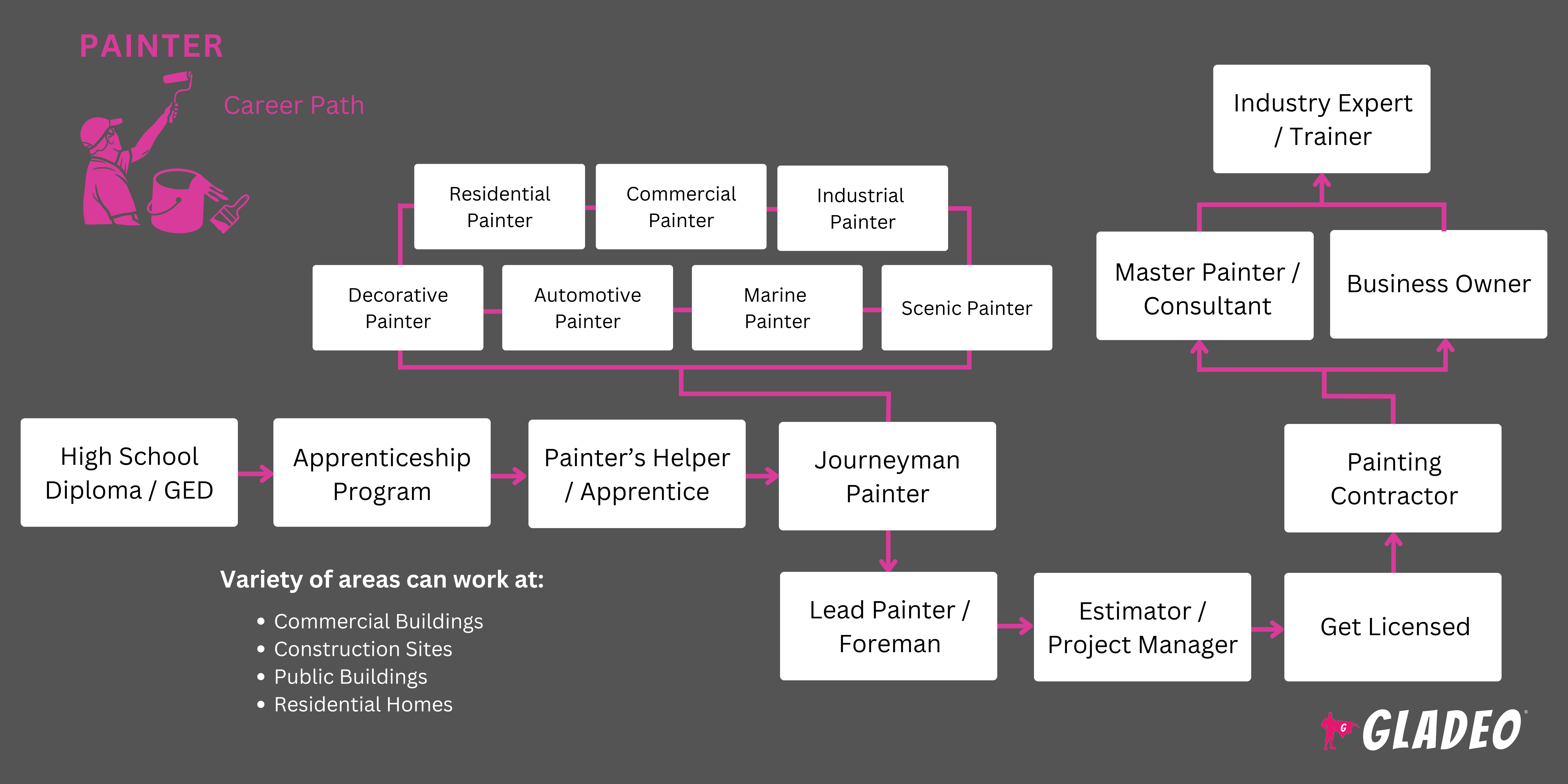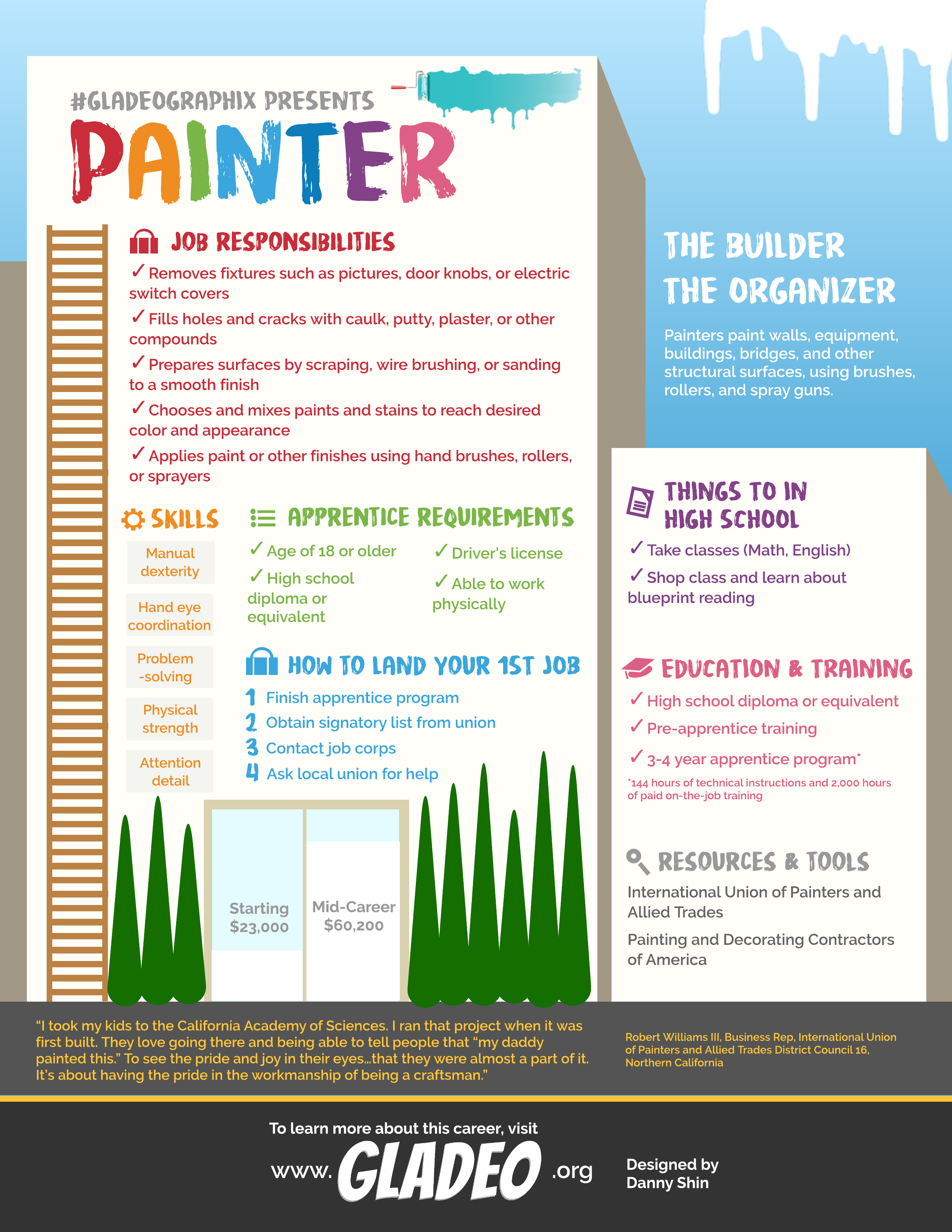Spotlights
Facilities Painter, Highway Painter, House Painter, Industrial Painter, Maintenance Painter, Painter
Painters paint walls, equipment, buildings, bridges, and other structural surfaces, using brushes, rollers, and spray guns.
- A sense of accomplishment when you finish a project
- Autonomy: You can work as much and as little as you want.
- Typically you start at 6:30am-3:30pm: Able to do other projects in the afternoon.
- Work with your hands!: “When you are mechanically inclined, the trades are excellent for that.”
- Travel: If you are an international painter, you could do a job in another country if you want to. When you are young before you have a family and want to travel, you can work in different states and even different countries.
“I took my kids to the California Academy of Sciences. I ran that project when it was first built. They love going there and being able to tell people that “my daddy painted this.” To see the pride and joy in their eyes…that they were almost a part of it. It’s about having the pride in the workmanship of being a craftsman.” Robert Williams III, Business Rep, International Union of Painters and Allied Trades District Council 16, Northern California
- Covers floors and furniture with drop-cloths and tarps to protect surfaces.
- Removes fixtures such as pictures, door knobs, or electric switch covers.
- Puts up scaffolding and set up ladders.
- Fills holes and cracks with caulk, putty, plaster, or other compounds.
- Prepares surfaces by scraping, wire brushing, or sanding to a smooth finish.
- Calculates the area to be painted and the amount of paint needed.
- Applies primers or sealers so the paint will adhere.
- Chooses and mixes paints and stains to reach desired color and appearance.
- Applies paint or other finishes using hand brushes, rollers, or sprayers.
- Manual dexterity: good with your hands
- Hand eye coordination
- Critical thinking and problem-solving: You will encounter unexpected problems and you will have to figure them out in a timely fashion.
- Attention to detail
- Physical strength and stamina
- Construction painters apply paints, stains, and coatings to interior and exterior walls, new buildings, and other structural surfaces.
- Maintenance painters remove old finishes and apply paints, stains, and coatings later in a structure’s life. Some painters specialize in painting or coating industrial structures, such as bridges and oil rigs, to prevent corrosion.
- Artisan painters specialize in creating distinct finishes by using one of many decorative techniques. One technique is adding glaze for added depth and texture. Other common techniques may include sponging, distressing, rag-rolling, color blocking, and faux finishes.
- Painting and coating workers apply materials to manufactured products, such as furniture, toys and pottery, as well as transportation equipment including trucks, buses, boats, and airplanes. For more information about these painters, see the profile on painting and coating workers.
- Painting and covering contractor company: Range from mom and pop shop (4-8 painters) to large shops (200+ painters)
- It’s common that you stay with one contractor your whole career but you can also move around.
- Indoors and Outdoors: Because painters apply finishes to a wide variety of structures—from bridges to the interiors and exteriors of buildings.
- Physical: Requires a lot of climbing, bending, kneeling, and stretching.
- Union negotiates competitive rates: For example) In SF Bay Area, $33.86 per hour as journeyman which is the position after you are an apprentice.
- Full medical benefits (medical, dental, vision)
- Pension
- Annuity
- Access to better jobs and amazing opportunities
“I’ve worked on the Golden Gate bridge, the top of the tower of the new Bay Bridge, and every aspect of the California Academy of Sciences. Those opportunities would not have been given to me if I wasn’t a union painter.” Robert Williams III, Business Rep, International Union of Painters and Allied Trades District Council 16, Northern California
- Dangerous: Those who paint bridges or building infrastructure may be exposed to extreme heights and uncomfortable positions; some painters work suspended with ropes or cables.
- Irregular work schedule: Sometimes you might work really early in the morning. Sometimes at night.
- Might have to drive long distance for job site.
- Building and fixing things! : working with your hands
- Being outside in nature.
- Sports
- "I liked working on cars."
“Some of us we have more Neanderthal DNA than others. You’ve got to be able to express that in the best way possible. We all have a sense of creativity that can be shown and it’s finding that way to show that creativity. Some people they can do that behind a computer, other people it’s great to be able to build a building. It all comes into that sense of being of whatever makes you feel alive.” Robert Williams III, Business Rep, International Union of Painters and Allied Trades District Council 16, Northern California
- A high school diploma/GED may be needed, but there are no formal educational requirements
- Painters generally learn their trade on the job. Some qualify for supervised apprenticeships which can last 3 or 4 years
- Apprenticeships are sponsored by unions, such as the International Union of Painters and Allied Trades and Finishing Trades Institute
- Technical instruction covers proper tool and equipment usage, preparing surfaces, color matching, wall coverings, and scaffolding safety
- Occupational Safety and Health Administration safety training may also required
- Optional certification programs include:
- AMPP (Association for Materials Protection and Performance, formerly NACE and SSPC)
- Coatings application certification and training
- Abrasive blasting and surface preparation certification and training
- Environmental Protection Agency - Certification for lead paint abatement and Lead Renovation, Repair and Painting Program
- AMPP (Association for Materials Protection and Performance, formerly NACE and SSPC)
- ~39% of Painters are self-employed, so an associate’s in business can be handy
Unions and contractors sponsor apprenticeship programs. The basic qualifications to enter an apprenticeship program are as follows:
- Minimum age of 18
- Driver’s license
- High school diploma or equivalent (GED or take an aptitude test)
- Physically able to do the work
Click here for a list of programs.
- Take courses in high school such as shop, math, and art
- Have your color vision tested
- Start an exercise routine to build strength, stamina, flexibility, and balance
- Learn how to use and wear proper personal protective equipment
- Obtain your driver’s license so you can make it to job sites
- Learn as much as you can on your own about painting for construction and maintenance. Study books, articles, and video tutorials
- Volunteer for painting projects to gain hands-on practical experience
- Get certified in a specialized area to bolster your credentials
- Ask an Painter if you can shadow them to learn about day-to-day activities and tools used
- 39.8% with HSDiploma
- 4% with Associate’s
- 6.1% with Bachelor’s
- 1% with Master’s
- 0.3% with Professional

- Finish the apprenticeship program (note: you are working with pay while you are an apprentice)
- Union will give you the signatory list: local union will give you some leads, you start making calls to contractors on the list.
- Contact Job Corps
- Ask the local union for help. They will put you on the "out of work" list.
- If taking classes at a trade or vocational school, ask their career center for assistance
- Let potential employers know you plan to stick through the long apprenticeship process and earn your license when the time comes
- Make sure you understand state licensure requirements for lead paint removal
- Review the EPA’s Lead Renovation, Repair and Painting Program for details
- Estimator: Budgets the job then bids on the job.
- Project Manager: Behind the scenes, paperwork. Make sure request for information is filled out. Money is getting paid. Work in conjunction with Superintendent.
- Superintendent: Takes care of the manpower needs on a jobsite. Materials and workers.
- Foreman: Takes care of the job.
- Lead person: Right hand man of the foreman.
- Dedication
- Person who is best with tools and the union elevates these people.
- Leader/Teacher: someone who knows the craft so well and they teach others.
Websites
- Associated Builders and Contractors
- Association for Materials Protection and Performance, formerly NACE and SSPC
- Home Builders Institute
- International Union of Painters and Allied Trades
- National Center for Construction Education and Research
- Painting and Decorating Contractors of America
- The Associated General Contractors of America
Books
- House Painting: Inside and Out (Fine Homebuilding), by Mark Dixon
- House Painting Business Guide: All The House Painting Ideas and Business Tips You Need For Hiring Painting
- Contractors, Exterior Home Painting And...Start A Small Business Painting Houses, by Yani H. Cortez
- Smart Guide (R): Painting: Interior and Exterior Painting Step by Step, by Editors of Creative Homeowner
Related Careers: Carpenter, Painting and Coasting workers, Plasterers
“You can get what you want out of it depending on how hard you want to invest yourself into it and how dedicated you want to be. You can just get by or you can flourish and rise up in the industry. It’s all up to the individual.” Robert Williams III, Business Rep, International Union of Painters and Allied Trades District Council 16, Northern California
Newsfeed

Featured Jobs

Online Courses and Tools

Annual Salary Expectations
New workers start around $49K. Median pay is $60K per year. Highly experienced workers can earn around $78K.






